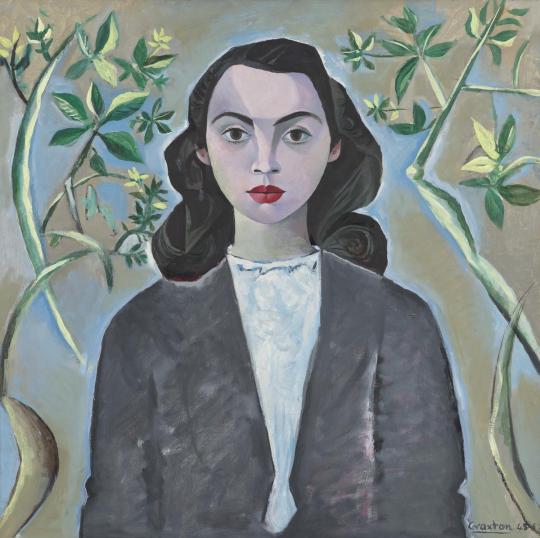Text

Freedom, January 1915
2 notes
·
View notes
Photo
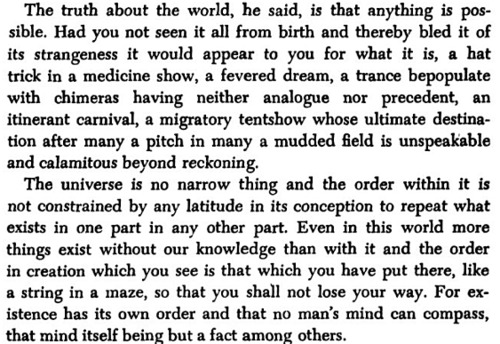
- Blood Meridian or The Evening Redness In The West, 1985
R.I.P. Cormac McCarthy
898 notes
·
View notes
Text
The self-fulfilling prophecy of domination, competition, and violent conflict.
"But how is it possible to have history a priori? The answer is that it is possible if the prophet himself occasions and produces the events he predicts. [...] Our politicians, so far as their influence extends, behave in exactly the same way, and they are just as successful in their prophecies. One must take men as they are, they tell us, and not as the world's uninformed pedants and good-natured dreamers fancy that they ought to be. But 'as they are' ought to read 'as we have made them by unjust coercion, by treacherous designs which the government is in a good position to carry out.' For that is why they are intransigent and inclined to rebellion, and why regrettable consequences ensue if discipline is relaxed in the slightest."
A Renewed Attempt to Answer the Question: 'Is the Human Race Continually Improving?', by Immanuel Kant
"Poor human nature, what horrible crimes have been committed in thy name! Every fool, from king to policeman, from the flatheaded parson to the visionless dabbler in science, presumes to speak authoritatively of human nature. The greater the mental charlatan, the more definite his insistence on the wickedness and weaknesses of human nature. Yet, how can any one speak of it today, with every soul in a prison, with every heart fettered, wounded, and maimed? [...] With human nature caged in a narrow space, whipped daily into submission, how can we speak of its potentialities? Freedom, expansion, opportunity, and, above all, peace and repose, alone can teach us the real dominant factors of human nature and all its wonderful possibilities."
Anarchism: What It Really Stands For, by Emma Goldman
"The state and the bourgeoisie erect a system of military defense of private property, of the circulation of money and commodities, unleashing at the same time the war of all against all, the fiercest conflict of isolated interests. The authority of the state thus finds its basis again in the confused hostility that reigns over society in its totality. [...] Violence is first of all the conditions that are imposed on us. [...] the most brutal reign of necessity has effectively exacerbated the hostility and competition that regulates relationships among the poor in society. Isolation and atomization dominate everything without contest. An atmosphere of anxiety and oppression never before known comes out of this. [...] In the midst of the misery itself, the attributes of every advanced society are discovered: the police and the democratic lie."
A Crime Called Freedom, by Os Cangaceiros
#immanuel kant#emma goldman#os cangaceiros#kant#human nature#necessity#domination#hierarchy#competition#violence#social conflict#bellum omnium contra omnes#anarchism#freedom#liberty#equality#solidarity#cooperation#the state#capitalism#market economy#police#democracy#class struggle
0 notes
Text
"There is often a most shocking disparity between the revolutionary circumstances that accompany the emergence of an institution and the manner in which it functions, which is completely opposed to the ideals of its naive founders. At its birth, there may be cries of "Liberty! Liberty!" and the hymn "War against the Tyrants" may resound in the streets; however, "tyrants" still manage to come into their midst as the direct result of the routine, the hierarchy, and the spirit of regression that gradually encroach on every institution. The longer any institution persists, the more formidable it becomes, for it finally rots the very soil on which it stands and pollutes the atmosphere around it."
Evolution, Revolution, and the Anarchist Ideal, by Élisée Reclus
0 notes
Text
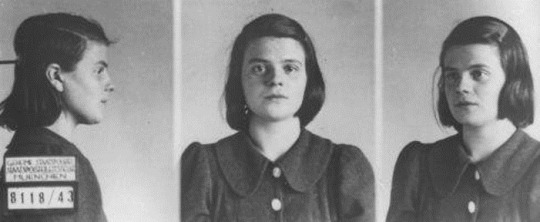
"The real damage is done by those millions who want to ‘survive.’ The honest men who just want to be left in peace. Those who don’t want their little lives disturbed by anything bigger than themselves. Those with no sides and no causes. Those who won’t take measure of their own strength, for fear of antagonizing their own weakness. Those who don’t like to make waves—or enemies. Those for whom freedom, honour, truth, and principles are only literature. Those who live small, mate small, die small. It’s the reductionist approach to life: if you keep it small, you’ll keep it under control. If you don’t make any noise, the bogeyman won’t find you. But it’s all an illusion, because they die too, those people who roll up their spirits into tiny little balls so as to be safe. Safe?! From what? Life is always on the edge of death; narrow streets lead to the same place as wide avenues, and a little candle burns itself out just like a flaming torch does. I choose my own way to burn."
Sophie Scholl
2 notes
·
View notes
Photo
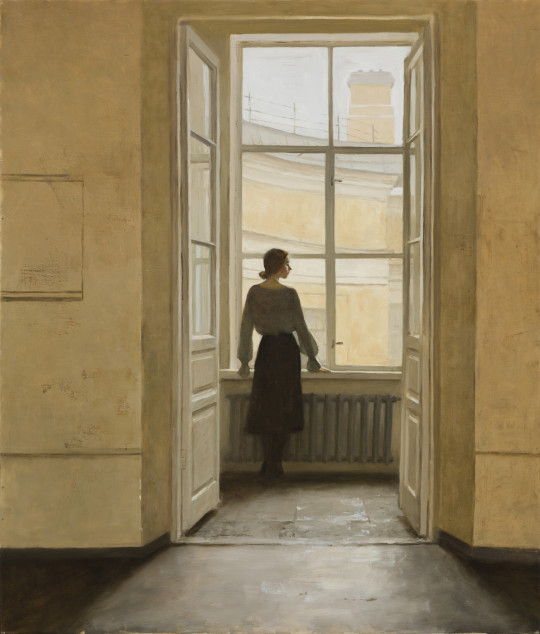
Bright expectations - Ksenya Istomina,
Russian, b. 1991 -
Oil on canvas , 100 x 95 cm.
759 notes
·
View notes
Text
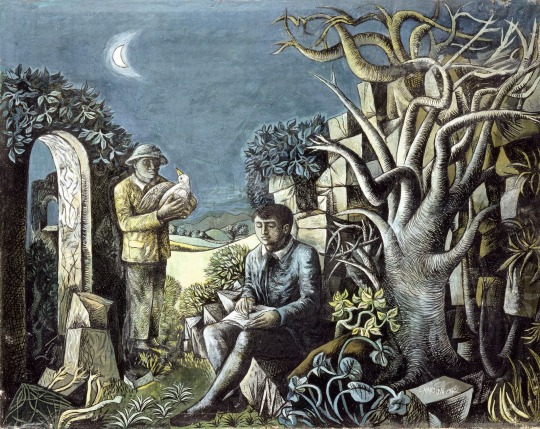
Landscape with Poet and Birdcatcher, by John Craxton
0 notes
Text
"…and the devil himself lights the lamps only so as to show everything not as it really looks"
Nevsky Prospect, by Nikolai Gogol
1 note
·
View note
Text
" I believe that the poet is necessarily an anarchist, and that he must oppose all organized conceptions of the state, not only those which we inherit from the past, but equally those which are imposed on people in the name of the future.
— Herbert Read, Poetry and Anarchism (1938)
11 notes
·
View notes
Text
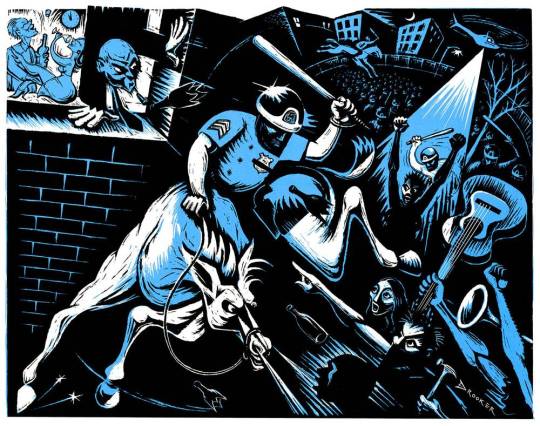
"My neighborhood was a place of unrest. I lived right down the block from Tompkins Square Park, where the police attempted to enforce a midnight curfew, in 1988. The park sits in the heart of Lower East Side, a volatile neighborhood with a long, radical history of resistance. So, when a police megaphone ordered everyone out of the park one hot summer night, we all refused to leave. The crowd just stood there, chanting: "Whose fucking park? OUR fucking park!" Then without warning, riot police charged into the crowd on horseback. Screaming and chaos ensued. People reacted by throwing bottles, bricks, and firecrackers at the cops. I took it all personally. This was the park I'd grown up in... my playground as a child. I'd never seen this level of violence firsthand - I saw the police just cracking people's skulls open and galloping into the crowd - helicopters hovering above tenements - an unforgettable, apocalyptic scene. I saw my friends and neighbors fighting against the helmeted police - rebelling against the landlords... and it was inspiring as hell. Oh, it was picturesque indeed: nocturnal hordes of uniformed men on horseback, swinging shiny batons. I immediately began working on my next street poster, 'Police Riot', which was wheat-pasted on lampposts and walls throughout the neighborhood. Later I used this image in Flood!'s riot sequence. Ultimately, the band Rage Against the Machine used it as a CD cover."
Eric Drooker
{pictured: Police Riot, by Eric Drooker}
#eric drooker#art print#poster art#tompkins square park#police riot#police brutality#social control#Flood!#rage against the machine#rebellion#resistance
2 notes
·
View notes
Text
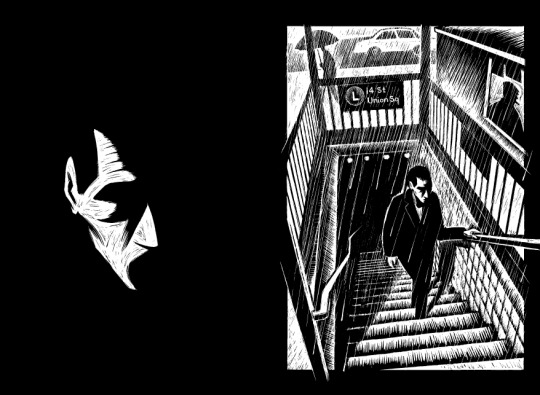

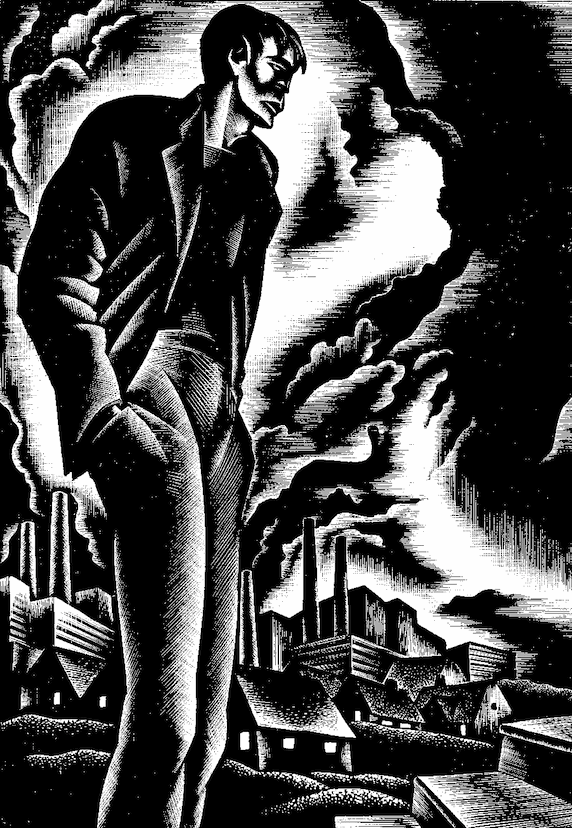
Chris Lanier: "Your grandfather was an influence on you, in pursuing art..."
Eric Drooker: "My grandfather introduced me to silent storytelling when I was a boy. He showed me several woodcut novels, which were popular in the 1930s, when he was a young man. None of the books had any words in them, only stark black-and-white images."
Chris: "What woodcut novels did your grandfather show you?"
Eric: "When I was about twelve, he gave me two wordless books, Passionate Journey and The City, by Frans Masereel, the Belgian expressionist. He said, 'Take a look at these books, they're written without using any words.' I was intrigued, but could hardly penetrate the books. They were too serious ... not cartoony enough - or linear enough - for me to grasp. But over the years, I'd occasionally crack these books open and marvel: 'Hmm ... Entire stories told in pictures - in woodcuts, no less!' Each year they affected me more and more ... until I began to feel haunted by these silent books. In my early twenties, I began to study Masereel's technique, and after Sue Coe gave me a huge anthology of his work, I became possessed by his vision."
Chris: "Have you seen any other woodcut novels?"
Eric: "I'd stumbled upon a collection of woodcut novels by Lynd Ward, the American illustrator. His book Storyteller without Words contains all his silent stories, including Gods' Man and Vertigo. I was deeply moved by his art, and inspired by the social realism in his work."
{pictured: prints by Eric Drooker, Frans Masereel, and Lynd Ward, in that order}
#eric drooker#frans masereel#lynd ward#prints#art prints#wordless novels#woodcut#scratchboard#woodcut novel
3 notes
·
View notes
Text
And some there are, guided by destiny,
Whose sacred bond will one day slip
Into immortal fellowship
That beams a mighty luminescence
Upon us (be assured of this),
And furnishes the world with bliss.
Yevgeny Onegin, by Alexander Pushkin
1 note
·
View note
Photo

Cat on the stairs - Frans Masereel, 1928.
Belgian, 1889-1972
Woodcut, 28 x 20 cm.
2K notes
·
View notes
Text
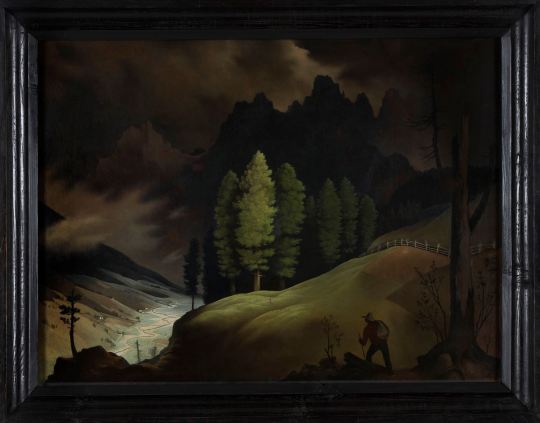

Bavarian Landscape, and Evening Landscape, by Franz Sedlacek
5 notes
·
View notes

